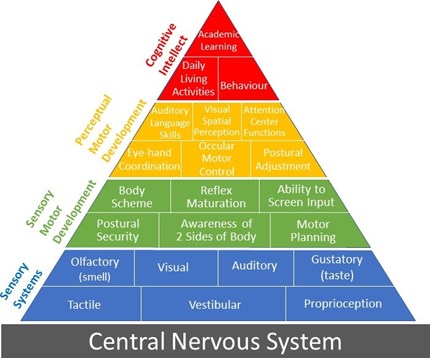Home is usually a child’s ‘safe space’ so it is not uncommon for them to let go and meltdown the day’s difficulties when they get into this space. This can make unpicking behaviours even more difficult as they may be reacting to something that has happened earlier in the day.
Self-regulation
Self-regulation involves monitoring and controlling feelings, emotions and behaviour. It requires the ability to pay attention to relevant stimuli but block out irrelevant stimuli, as well as controlling impulses and persisting with the task at hand. Therefore, effective processing of sensory information from the world around us is crucial to regulation and daily functioning. The area of the brain called the limbic system is involved in processing sensations, as well as emotional regulation.
Emotional regulation difficulties
Emotional regulation is the ability to present a levelled emotional response when exposed to highly stimulating situations. This skill is essential for maintaining emotional well-being which creates the foundation for healthy behaviours. Therefore, it makes sense that children who experience difficulties with self-regulation and modulation of sensory input can also present with emotional regulation difficulties.
Watch this video to learn more about emotional regulation.
The fight, flight or freeze response
Our fight, flight, freeze response is triggered when our body responds to something it has perceived as harmful or as a threat to our survival. This triggers us to fight (hit out), flight (run away) or freeze (like a ‘deer in the headlights’). Problems arise when our brain perceives something as harmful or a threat but it isn’t and this is what we commonly see with children who are experiencing sensory processing and emotional regulation difficulties.
Ideas to support Emotional Regulation
- Learning to calm one’s physical body is a vital aspect of regulating emotions and sensory stimulation. It is important for children to learn calming and relaxing strategies to help them when feeling overwhelmed.
-
- Deep breathing activities.
- Going for a walk or other physical exercise.
- Having a quiet, calm down space for the child to retreat to. You can have heavy items or fidget toys in this space to support a calming feeling.
-
- Activities involving blowing e.g. blowing out a pretend candle, blowing up a balloon, blowing bubbles through a straw, straw blow ‘football’ (scrunched up paper) or having a drink through a straw.
- Yoga
- Providing regular proprioceptive input and heavy work activities during the day to support body awareness and modulation.
- Identifying emotions and helping the child label these when they are feeling them e.g. ‘I can see that is making you feel a little frustrated. What can we do to help you calm down and we can do the job together’ or ‘I can see you are going into the yellow zone, what can we do to help you get back into the green zone’.
- ‘The Zones of Regulation’ is a handy tool to explore with children. It links visuals, colours and emotions to body feelings. It helps identify sensory ‘tools’ to support successful engagement and highlights how our zone or feelings can impact on others.



